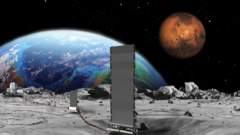With the moon becoming a focal point of global exploration, NASA is expediting efforts to deploy a nuclear reactor by 2030 to sustain a human base, despite budget cuts and concerns about the motivations behind such a race. Acting NASA head Sean Duffy has emphasized the urgency of building nuclear capabilities to support a future lunar economy, while recent reports show that competitors China and Russia are also making strides towards lunar energy independence.
Duffy's call for innovative reactor proposals comes in response to the challenges posed by the Moon's unique environment, where solar power's viability is limited due to extended periods of darkness. A reactor, generating at least 100 kilowatts, could provide essential energy needed for habitation and exploration, as the lunar day features two weeks of sunlight followed by two weeks of darkness.
Experts like Dr. Sungwoo Lim argue that nuclear energy is necessary to meet the significant power demands of lunar infrastructure that solar arrays alone cannot fulfill. Meanwhile, Professor Lionel Wilson advocates that while technically feasible within the timeline, adequate funding is crucial to establish the necessary infrastructure through NASA's Artemis program, which is intended to send humans and equipment to the Moon.
However, safety concerns regarding the transport of radioactive materials and the political implications of establishing territories on the Moon through the Artemis Accords remain prevalent. Dr. Simeon Barber raises alarms that competitive motivations may overshadow scientific exploration, as countries race to stake claims on lunar real estate by setting up operational safety zones around their developments.
Ultimately, while Duffy's announcement reflects a rejuvenated US initiative to lead the next phase of lunar exploration, experts caution that without cohesive planning and addressing fundamental logistical concerns, the ambitious goals may face significant hurdles. The trajectory of lunar missions could redefine international cooperation and ownership in space, and the quest for nuclear energy beyond Earth may just be beginning.
Amidst these complex layers of exploration, one question remains: Who truly owns the Moon and how will future advancements shape the collaborative landscape of space travel?
Duffy's call for innovative reactor proposals comes in response to the challenges posed by the Moon's unique environment, where solar power's viability is limited due to extended periods of darkness. A reactor, generating at least 100 kilowatts, could provide essential energy needed for habitation and exploration, as the lunar day features two weeks of sunlight followed by two weeks of darkness.
Experts like Dr. Sungwoo Lim argue that nuclear energy is necessary to meet the significant power demands of lunar infrastructure that solar arrays alone cannot fulfill. Meanwhile, Professor Lionel Wilson advocates that while technically feasible within the timeline, adequate funding is crucial to establish the necessary infrastructure through NASA's Artemis program, which is intended to send humans and equipment to the Moon.
However, safety concerns regarding the transport of radioactive materials and the political implications of establishing territories on the Moon through the Artemis Accords remain prevalent. Dr. Simeon Barber raises alarms that competitive motivations may overshadow scientific exploration, as countries race to stake claims on lunar real estate by setting up operational safety zones around their developments.
Ultimately, while Duffy's announcement reflects a rejuvenated US initiative to lead the next phase of lunar exploration, experts caution that without cohesive planning and addressing fundamental logistical concerns, the ambitious goals may face significant hurdles. The trajectory of lunar missions could redefine international cooperation and ownership in space, and the quest for nuclear energy beyond Earth may just be beginning.
Amidst these complex layers of exploration, one question remains: Who truly owns the Moon and how will future advancements shape the collaborative landscape of space travel?


















